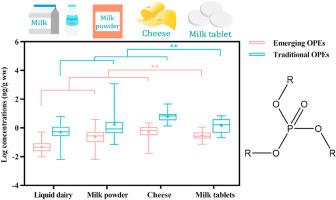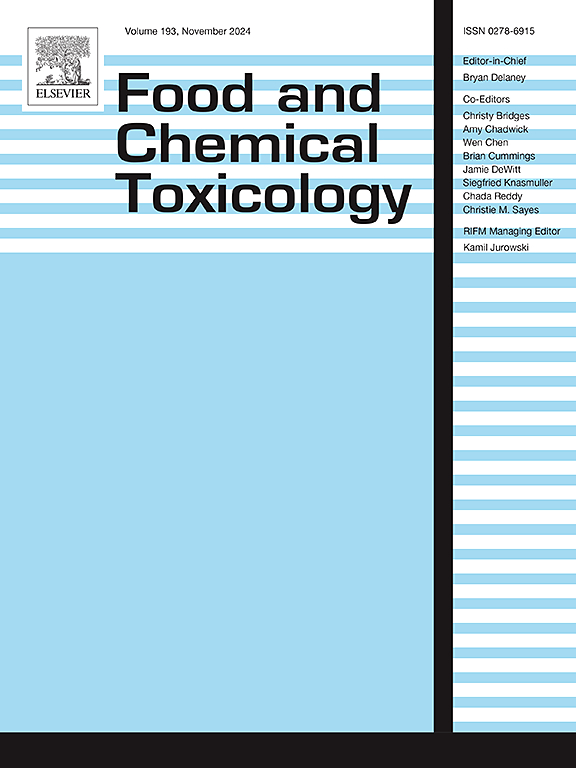中国乳制品中新出现的和传统的有机磷酯类阻燃剂含量及其综合膳食风险评估。
IF 3.9
3区 医学
Q2 FOOD SCIENCE & TECHNOLOGY
引用次数: 0
摘要
我们对中国收集的 182 种乳制品中的 25 种新出现的和传统的有机磷酸酯(OPEs)进行了全面调查。所有乳制品样品中的总 OPEs(ΣOPEs)浓度介于 0.0261 至 1178 纳克/克(湿重)之间。主要污染物是磷酸三乙酯(比例:93%)和磷酸三(1-氯-2-异丙基)酯(比例:2%)。在各类乳制品中,ΣOPEs 的浓度按以下顺序下降:奶粉(平均:80.8 纳克/克湿重,比例:86%)> 奶酪(9.43 纳克/克湿重,10%)> 奶片(2.72 纳克/克湿重,3%)> 液体乳制品(1.05 纳克/克湿重,1%)。新兴 OPE 与传统 OPE 之间的明显相关性表明,它们可能具有相似的来源,或在商业应用中被同时使用。OPEs污染与OPEs特性、本地OPEs生产和应用以及乳制品类型有关。就中国普通人群而言,每天通过乳制品摄入的 ΣOPEs 平均值和最高值分别为 31.5 纳克/千克体重和 83.6 纳克/千克体重。幼儿和儿童的乳制品暴露量高于其他年龄组。虽然 ΣOPEs 的高暴露风险为 3.50 × 10-3,但潜在毒性磷酸三(1-氯-2-异丙基)酯占总危害商数的 38%。本文章由计算机程序翻译,如有差异,请以英文原文为准。

An assessment of the levels of emerging and traditional organophosphate ester flame retardants in dairy products in China and their combined dietary risks
A comprehensive survey was conducted by investigating 25 emerging and traditional organophosphate esters (OPEs) in 182 dairy products collected in China. The concentrations of total OPEs (ΣOPEs) ranged from 0.0261 to 1178 ng/g wet weight (ww) in all the dairy samples. The major contaminants were triethyl phosphate (proportion: 94 %) and tris(1-chloro-2-isopropyl) phosphate (proportion: 2 %). Among types of dairy products, the concentrations of ΣOPEs decreased in the following order: milk powder (mean: 80.8 ng/g ww, proportion: 86 %) > cheese (9.43 ng/g ww, 10 %) > milk tablets (2.72 ng/g ww, 3 %) > liquid dairy (1.05 ng/g ww, 1 %). The significant correlation between emerging and traditional OPEs suggests that they likely share similar sources or are used together in commercial applications. OPEs contamination was related to the OPEs properties, local OPEs production and application, and dairy types. For the general Chinese population, the average and high estimated daily intakes of ΣOPEs via dairy products were 31.5 and 83.6 ng/kg bw/day, respectively. Dairy exposure in toddlers and children were higher than other age groups. Although the high-exposure risk of ΣOPEs was 3.50 × 10−3, potentially toxic tris(1-chloro-2-isopropyl) phosphate accounted for 38 % of the total hazard quotients.
求助全文
通过发布文献求助,成功后即可免费获取论文全文。
去求助
来源期刊

Food and Chemical Toxicology
工程技术-毒理学
CiteScore
10.90
自引率
4.70%
发文量
651
审稿时长
31 days
期刊介绍:
Food and Chemical Toxicology (FCT), an internationally renowned journal, that publishes original research articles and reviews on toxic effects, in animals and humans, of natural or synthetic chemicals occurring in the human environment with particular emphasis on food, drugs, and chemicals, including agricultural and industrial safety, and consumer product safety. Areas such as safety evaluation of novel foods and ingredients, biotechnologically-derived products, and nanomaterials are included in the scope of the journal. FCT also encourages submission of papers on inter-relationships between nutrition and toxicology and on in vitro techniques, particularly those fostering the 3 Rs.
The principal aim of the journal is to publish high impact, scholarly work and to serve as a multidisciplinary forum for research in toxicology. Papers submitted will be judged on the basis of scientific originality and contribution to the field, quality and subject matter. Studies should address at least one of the following:
-Adverse physiological/biochemical, or pathological changes induced by specific defined substances
-New techniques for assessing potential toxicity, including molecular biology
-Mechanisms underlying toxic phenomena
-Toxicological examinations of specific chemicals or consumer products, both those showing adverse effects and those demonstrating safety, that meet current standards of scientific acceptability.
Authors must clearly and briefly identify what novel toxic effect (s) or toxic mechanism (s) of the chemical are being reported and what their significance is in the abstract. Furthermore, sufficient doses should be included in order to provide information on NOAEL/LOAEL values.
 求助内容:
求助内容: 应助结果提醒方式:
应助结果提醒方式:


